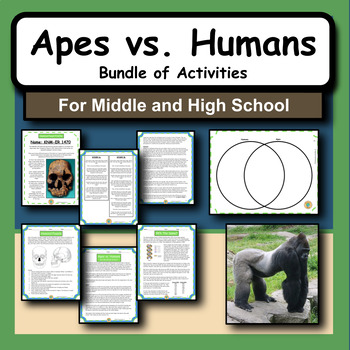Apes vs. Humans: Challenging Evolution Bundle of Activities for Science Class
- Zip
Products in this Bundle (3)
Also included in
- This massive bundle includes thousands of pages of material and it gives you freedom to not have to worry about prepping for much of the school year. These engaging activities encourage students to learn and grow their skills in critical thinking and mastery. Each activity is associated with eitherPrice $575.00Original Price $725.60Save $150.60
- The Theory of Evolution is very well-known throughout the world and it is a way to explain why we see many so species of animals and plant life today. This bundle includes four different activities: Slides Presentation, Comparing Apes and Humans, 98% the Same? Genome Sequencing, and Examining HominiPrice $12.00Original Price $14.75Save $2.75
Description
The Theory of Evolution is very well-known throughout the world and it is a way to explain why we see many so species of animals and plant life today. This bundle includes three different activities: Comparing Apes and Humans, 98% the Same? Genome Sequencing, and Examining Hominid Fossils. You can read a summary of each below:
1. Comparing Apes and Humans Activity:
One of the pieces of this theory is that humans and the apes of today share a common ancestor. This activity is designed for students to begin this comparison of the apes of today and humans-to see that there are many similarities but also many differences.
First, students will be given the provided packet. Then, they will read through the passage (about two pages). As they read, they can underline and/or highlight the similarities and differences that they see between apes and humans.
Then, they will fill in the provided Venn Diagram on the last page of their packet, which compares and contrasts apes and humans.
As a class, they can discuss what they found and as an extension, they can do their own research to add to their Venn Diagrams.
This activity includes teacher procedure directions and student packet answers. It also has a copy of the student passage for the teacher, which has comparisons highlighted and contrasts underlined, for your convenience.
This activity is designed to be written from a more neutral perspective: allowing for students to see the incredible, especially cognitive, differences between humans and apes and to show many of the similarities as well.
This product includes:
- Teacher Directions-including prep info and materials needed
- Teacher Procedure
- “Apes vs. Humans” Student Packet: Two page reading about apes and humans; then a Venn Diagram page
- Student Packet Venn Diagram Answers
- Teacher Copy of student reading with highlighted and underlined comparisons and contrasts.
- Citations
- Teacher Tips
To do this activity, students will need:
- Pencil
- Copy of "Apes vs. Humans" packet (INCLUDED)
2. 98% the Same? Genome Sequencing Activity:
One of the pieces of this theory that scientists claim that we are 90%-99% the same as chimps, when we compare the DNA of humans and chimps. This is due to genome sequencing.
However, when we actually read about HOW scientists compared the DNA sequences between humans and chimps, we see that they actually excluded over a third of the DNA itself when they were compared.
In this activity, students will read about DNA, base pairs, genome sequencing, mutations and how scientists excluded parts of the DNA in both humans and chimps. For example, if they found mutations, they would cut it out, if they found duplicates, they would cut it out, etc.
Then, students will read two different stories and compare them. They will then cross out any 'mutations,' duplicates, and any paragraphs that are in different spots in the other story. They will end with only a few sentences that don't make sense on their own.
Then, students will answer questions about the remaining stories and what they learned. You can then discuss what they've learned.
This product is designed for students to think through how there are pieces of "evidence" that should be questioned, as in all aspects of science.
This product includes:
- Teacher Directions-including prep info and materials needed
- Teacher Procedure
- “98% the Same?” Four-Page Student Packet
- Student Packet Questions Answers
- Student Packet Story Answers
- Citations
- Teacher Tips
To do this activity, students will need:
- Pencil
- Copy of "98% the Same?" packet (INCLUDED)
3. Examining Hominid Fossils:
One of the pieces of evolution that scientists claim that we are a species evolved from an ape-like ancestor who was also the ancestor of modern-apes.
Scientists claim that there are many "transitional fossils" between the ape ancestor and modern day humans, that reflect this evolution. However, when we really examine the fossils and compare them to modern day human and ape fossils, we actually see that they all reflect either an ape or a human, but not both. (Even many evolutionist scientists say these things when examining the evidence).
This activity is designed to teach students about these Hominid fossils and how, when comparing these fossils to modern fossils, we can determine them as either ape or human.
First, students will read about the comparisons between modern human fossils and modern ape fossils. Then, they will go around the room and read about 10 well-known hominid fossils. They will write the names of them, characteristics of the fossil, whether it's a human or ape, and why the fossil was famous.
These are the fossils it covers:
- Lucy
- Toumai
- Turkana Boy
- Laetoli Footprints
- Taung Child
- KNM-ER 1470
- KNM-ER 1813
- Ardi
- Selam (Lucy's baby)
- Herto Skulls
Finally, students will answer 10 analysis questions about this activity, the fossils and scientific bias.
There is NO mention of intelligent design or creationism in this product. However, this product was created from a scientific worldview that opposes the theory of evolution.
This product includes:
- Teacher Directions-including prep info and materials needed
- Teacher Procedure
- 4-Page “Hominid Fossils” Student Packet
- 10 Hominid Fossil Profile Sheets
- Hominid Fossil Chart Answers
- Student Packet Questions Answers
- Citations
- Teacher Tips
To do this activity, students will need:
- Pencil
- Copy of "Hominid Fossils" packet (INCLUDED)
- Copy of 10 "Hominid Fossil Profile" sheets (INCLUDED)
Check out my other science resources!
Join my email list here to learn about ways to encourage students to experience the content!
Follow my store to be notified when new products are added!
You can also follow me on Pinterest, Instagram, Facebook and YouTube!
If you have any questions, feel free to email me at edventureswithmrsd@gmail.com.
Thank you!







